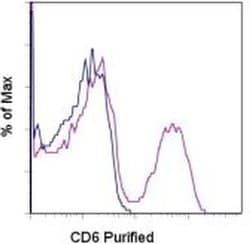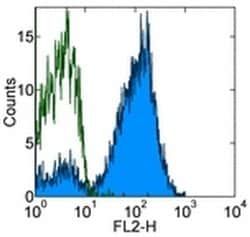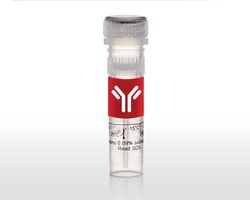14-006-137
CD6 Monoclonal Antibody (IM348), eBioscience™, Invitrogen™
Manufacturer: Invitrogen
Select a Size
| Pack Size | SKU | Availability | Price |
|---|---|---|---|
| Each of 1 | 14-006-137-Each-of-1 | In Stock | ₹ 1,22,108.00 |
14-006-137 - Each of 1
In Stock
Quantity
1
Base Price: ₹ 1,22,108.00
GST (18%): ₹ 21,979.44
Total Price: ₹ 1,44,087.44
Antigen
CD6
Classification
Monoclonal
Concentration
0.5 mg/mL
Formulation
PBS with 0.09% sodium azide; pH 7.2
Gene Accession No.
Q61003
Gene Symbols
CD6
Purification Method
Affinity chromatography
Regulatory Status
RUO
Gene ID (Entrez)
12511
Content And Storage
4° C
Form
Liquid
Applications
Flow Cytometry, Immunohistochemistry (Frozen), Western Blot
Clone
IM348
Conjugate
Unconjugated
Gene
CD6
Gene Alias
Cd6; CD6 antigen; CD6 antigen, Tp120; Cd6 molecule; FLJ44171; OX52; Soluble CD6; T12; T-cell differentiation antigen CD6; TP120
Host Species
Rat
Quantity
2 mg
Primary or Secondary
Primary
Target Species
Mouse
Product Type
Antibody
Isotype
IgG2a
Description
- The MAb IM348 recognizes mouse CD6, a transmembrane glycoprotein of the scavenger receptor family
- The extracellular domain contains three scavenger receptor cysteine rich (SRCR) domains, a transmembrane region and a cytoplasmic domain of variable length depending on the isoform
- CD6 is expressed on most T lymphocytes
- Expression between human and mouse is slightly different
- In mice B cells in the spleen do not have CD6, while humans express it on a subset of B lymphocytes
- The CD6 ligand is CD166, also known as Activated Leukocyte Cell Adhesion Molecule (ALCAM)
- Through interactions with CD166 or homotypic CD6-CD6, a role exists in adhesion and migration during organogenesis
- The intracellular domain of CD6 is constitutively phosphorylated, suggesting a role in T cell activation and signaling
- In humans depletion of CD6-expressing cells increases graft versus host tolerance in transplants
- CD6, also known as T12, is a member of the scavenger receptor superfamily found on T and B cell subsets, thymocytes, and acute lymphocytic leukemia cells (ALL)
- CD6 interacts with its ligand CD166/ALCAM (activated leukocyte cell adhesion molecule) and serves as a coreceptor for T cell activation and stabilizer of the immunological synapse
- CD6-ALCAM mediated cell adhesion is also important for T cell proliferation
- CD6 may exert some its functions via association with CD5, probably by fine-tuning CD5 signaling
- Ligation of CD6 has antiapoptotic role in chronic lymphocytic leukemia B cells.
Compare Similar Items
Show Difference
Antigen: CD6
Classification: Monoclonal
Concentration: 0.5 mg/mL
Formulation: PBS with 0.09% sodium azide; pH 7.2
Gene Accession No.: Q61003
Gene Symbols: CD6
Purification Method: Affinity chromatography
Regulatory Status: RUO
Gene ID (Entrez): 12511
Content And Storage: 4° C
Form: Liquid
Applications: Flow Cytometry, Immunohistochemistry (Frozen), Western Blot
Clone: IM348
Conjugate: Unconjugated
Gene: CD6
Gene Alias: Cd6; CD6 antigen; CD6 antigen, Tp120; Cd6 molecule; FLJ44171; OX52; Soluble CD6; T12; T-cell differentiation antigen CD6; TP120
Host Species: Rat
Quantity: 2 mg
Primary or Secondary: Primary
Target Species: Mouse
Product Type: Antibody
Isotype: IgG2a
Antigen:
CD6
Classification:
Monoclonal
Concentration:
0.5 mg/mL
Formulation:
PBS with 0.09% sodium azide; pH 7.2
Gene Accession No.:
Q61003
Gene Symbols:
CD6
Purification Method:
Affinity chromatography
Regulatory Status:
RUO
Gene ID (Entrez):
12511
Content And Storage:
4° C
Form:
Liquid
Applications:
Flow Cytometry, Immunohistochemistry (Frozen), Western Blot
Clone:
IM348
Conjugate:
Unconjugated
Gene:
CD6
Gene Alias:
Cd6; CD6 antigen; CD6 antigen, Tp120; Cd6 molecule; FLJ44171; OX52; Soluble CD6; T12; T-cell differentiation antigen CD6; TP120
Host Species:
Rat
Quantity:
2 mg
Primary or Secondary:
Primary
Target Species:
Mouse
Product Type:
Antibody
Isotype:
IgG2a
Antigen: CD7
Classification: Monoclonal
Concentration: 0.5 mg/mL
Formulation: PBS with 0.09% sodium azide; pH 7.2
Gene Accession No.: P09564
Gene Symbols: CD7
Purification Method: Affinity chromatography
Regulatory Status: RUO
Gene ID (Entrez): 924
Content And Storage: 4° C
Form: Liquid
Applications: Flow Cytometry
Clone: eBio124-1D1 (124-1D1)
Conjugate: Unconjugated
Gene: CD7
Gene Alias: Cd7; CD7 antigen; CD7 antigen (p41); Cd7 molecule; GP40; LEU-9; p41 protein; T-cell antigen CD7; T-cell leukemia antigen; T-cell surface antigen Leu-9; Tp40; TP41
Host Species: Mouse
Quantity: 2 mg
Primary or Secondary: Primary
Target Species: Human
Product Type: Antibody
Isotype: IgG1 κ
Antigen:
CD7
Classification:
Monoclonal
Concentration:
0.5 mg/mL
Formulation:
PBS with 0.09% sodium azide; pH 7.2
Gene Accession No.:
P09564
Gene Symbols:
CD7
Purification Method:
Affinity chromatography
Regulatory Status:
RUO
Gene ID (Entrez):
924
Content And Storage:
4° C
Form:
Liquid
Applications:
Flow Cytometry
Clone:
eBio124-1D1 (124-1D1)
Conjugate:
Unconjugated
Gene:
CD7
Gene Alias:
Cd7; CD7 antigen; CD7 antigen (p41); Cd7 molecule; GP40; LEU-9; p41 protein; T-cell antigen CD7; T-cell leukemia antigen; T-cell surface antigen Leu-9; Tp40; TP41
Host Species:
Mouse
Quantity:
2 mg
Primary or Secondary:
Primary
Target Species:
Human
Product Type:
Antibody
Isotype:
IgG1 κ
Antigen: CD8a
Classification: Monoclonal
Concentration: 0.5 mg/mL
Formulation: PBS with 0.09% sodium azide; pH 7.2
Gene Accession No.: P05541, P07725
Gene Symbols: Cd8a, CD8B
Purification Method: Affinity chromatography
Regulatory Status: RUO
Gene ID (Entrez): 24930, 24931
Content And Storage: 4° C
Form: Liquid
Applications: Flow Cytometry, Functional Assay, Immunohistochemistry (Frozen), Immunohistochemistry (Paraffin)
Clone: OX8
Conjugate: Unconjugated
Gene: Cd8a
Gene Alias: BB154331; CD8; CD8 alpha; CD8 alpha chain; CD8 alpha chain precursor; CD8 antigen; CD8 antigen 32 kDa chain; CD8 antigen 37 kDa chain; CD8 antigen alpha polypeptide; CD8 antigen alpha protein; CD8 antigen alpha protein precursor; CD8 antigen alpha-chain; CD8 antigen beta polypeptide; CD8 antigen beta polypeptide precursor; CD8 antigen beta-chain; CD8 antigen, alpha chain; CD8 antigen, alpha polypeptide; CD8 antigen, alpha polypeptide (p32); CD8 antigen, alpha-chain; CD8 antigen, beta chain; CD8 antigen, beta chain 1; CD8 antigen, beta polypeptide; CD8 antigen, beta polypeptide 1 (p37); CD8 antigen, beta-chain; CD8 beta; CD8 beta chain; CD8 beta-2; CD8a; CD8A antigen alpha; CD8a molecule; CD8A; T-cell surface glycoprotein; CD8alpha; CD8B; CD8b antigen; CD8b molecule; CD8b molecule pseudogene; Cd8b1; CD8beta; CD8BP; fCD8; LEU2; Leu-2; Leu2 T-lymphocyte antigen; leu-2a; Ly-2; LY3; Ly-3; Ly-35; Ly-B; Ly-C; Lymphocyte antigen 3; Lyt2; Lyt-2; Lyt-2.1 lymphocyte differentiation antigen (AA at 100); Lyt3; Lyt-3; MAL; membrane glycoprotein; membrane protein; OKT8 T-cell antigen; OX-8 membrane antigen; p32; P37; RHACD8-4; T cell co-receptor; T lymphocyte surface glycoprotein beta chain; T8 T-cell antigen; T-cell antigen Leu2; T-cell membrane glycoprotein Ly-3; T-cell surface glycoprotein; T-cell surface glycoprotein CD8 alpha chain; T-cell surface glycoprotein CD8 beta chain; T-cell surface glycoprotein Lyt-2; T-cell surface glycoprotein Lyt-3; T-cell surface molecule; T-lymphocyte differentiation antigen T8/Leu-2; type I transmembrane glycoprotein
Host Species: Mouse
Quantity: 2 mg
Primary or Secondary: Primary
Target Species: Rat
Product Type: Antibody
Isotype: IgG1 κ
Antigen:
CD8a
Classification:
Monoclonal
Concentration:
0.5 mg/mL
Formulation:
PBS with 0.09% sodium azide; pH 7.2
Gene Accession No.:
P05541, P07725
Gene Symbols:
Cd8a, CD8B
Purification Method:
Affinity chromatography
Regulatory Status:
RUO
Gene ID (Entrez):
24930, 24931
Content And Storage:
4° C
Form:
Liquid
Applications:
Flow Cytometry, Functional Assay, Immunohistochemistry (Frozen), Immunohistochemistry (Paraffin)
Clone:
OX8
Conjugate:
Unconjugated
Gene:
Cd8a
Gene Alias:
BB154331; CD8; CD8 alpha; CD8 alpha chain; CD8 alpha chain precursor; CD8 antigen; CD8 antigen 32 kDa chain; CD8 antigen 37 kDa chain; CD8 antigen alpha polypeptide; CD8 antigen alpha protein; CD8 antigen alpha protein precursor; CD8 antigen alpha-chain; CD8 antigen beta polypeptide; CD8 antigen beta polypeptide precursor; CD8 antigen beta-chain; CD8 antigen, alpha chain; CD8 antigen, alpha polypeptide; CD8 antigen, alpha polypeptide (p32); CD8 antigen, alpha-chain; CD8 antigen, beta chain; CD8 antigen, beta chain 1; CD8 antigen, beta polypeptide; CD8 antigen, beta polypeptide 1 (p37); CD8 antigen, beta-chain; CD8 beta; CD8 beta chain; CD8 beta-2; CD8a; CD8A antigen alpha; CD8a molecule; CD8A; T-cell surface glycoprotein; CD8alpha; CD8B; CD8b antigen; CD8b molecule; CD8b molecule pseudogene; Cd8b1; CD8beta; CD8BP; fCD8; LEU2; Leu-2; Leu2 T-lymphocyte antigen; leu-2a; Ly-2; LY3; Ly-3; Ly-35; Ly-B; Ly-C; Lymphocyte antigen 3; Lyt2; Lyt-2; Lyt-2.1 lymphocyte differentiation antigen (AA at 100); Lyt3; Lyt-3; MAL; membrane glycoprotein; membrane protein; OKT8 T-cell antigen; OX-8 membrane antigen; p32; P37; RHACD8-4; T cell co-receptor; T lymphocyte surface glycoprotein beta chain; T8 T-cell antigen; T-cell antigen Leu2; T-cell membrane glycoprotein Ly-3; T-cell surface glycoprotein; T-cell surface glycoprotein CD8 alpha chain; T-cell surface glycoprotein CD8 beta chain; T-cell surface glycoprotein Lyt-2; T-cell surface glycoprotein Lyt-3; T-cell surface molecule; T-lymphocyte differentiation antigen T8/Leu-2; type I transmembrane glycoprotein
Host Species:
Mouse
Quantity:
2 mg
Primary or Secondary:
Primary
Target Species:
Rat
Product Type:
Antibody
Isotype:
IgG1 κ
Antigen: CD8a
Classification: Monoclonal
Concentration: 0.5 mg/mL
Formulation: PBS with 0.09% sodium azide; pH 7.2
Gene Accession No.: P01732, P10966
Gene Symbols: Cd8a, CD8B
Purification Method: Affinity chromatography
Regulatory Status: RUO
Gene ID (Entrez): 925, 926
Content And Storage: 4° C
Form: Liquid
Applications: Immunohistochemistry (Paraffin)
Clone: C8/144B
Conjugate: Unconjugated
Gene: CD8B
Gene Alias: BB154331; CD8; CD8 alpha; CD8 alpha chain; CD8 alpha chain precursor; CD8 antigen; CD8 antigen 32 kDa chain; CD8 antigen 37 kDa chain; CD8 antigen alpha polypeptide; CD8 antigen alpha protein; CD8 antigen alpha protein precursor; CD8 antigen alpha-chain; CD8 antigen beta polypeptide; CD8 antigen beta polypeptide precursor; CD8 antigen beta-chain; CD8 antigen, alpha chain; CD8 antigen, alpha polypeptide; CD8 antigen, alpha polypeptide (p32); CD8 antigen, alpha-chain; CD8 antigen, beta chain; CD8 antigen, beta chain 1; CD8 antigen, beta polypeptide; CD8 antigen, beta polypeptide 1 (p37); CD8 antigen, beta-chain; CD8 beta; CD8 beta chain; CD8 beta-2; CD8a; CD8A antigen alpha; CD8a molecule; CD8A; T-cell surface glycoprotein; CD8alpha; CD8B; CD8b antigen; CD8b molecule; CD8b molecule pseudogene; Cd8b1; CD8beta; CD8BP; fCD8; LEU2; Leu-2; Leu2 T-lymphocyte antigen; leu-2a; Ly-2; LY3; Ly-3; Ly-35; Ly-B; Ly-C; Lymphocyte antigen 3; Lyt2; Lyt-2; Lyt-2.1 lymphocyte differentiation antigen (AA at 100); Lyt3; Lyt-3; MAL; membrane glycoprotein; membrane protein; OKT8 T-cell antigen; OX-8 membrane antigen; p32; P37; RHACD8-4; T cell co-receptor; T lymphocyte surface glycoprotein beta chain; T8 T-cell antigen; T-cell antigen Leu2; T-cell membrane glycoprotein Ly-3; T-cell surface glycoprotein; T-cell surface glycoprotein CD8 alpha chain; T-cell surface glycoprotein CD8 beta chain; T-cell surface glycoprotein Lyt-2; T-cell surface glycoprotein Lyt-3; T-cell surface molecule; T-lymphocyte differentiation antigen T8/Leu-2; type I transmembrane glycoprotein
Host Species: Mouse
Quantity: 2 mg
Primary or Secondary: Primary
Target Species: Human
Product Type: Antibody
Isotype: IgG1 κ
Antigen:
CD8a
Classification:
Monoclonal
Concentration:
0.5 mg/mL
Formulation:
PBS with 0.09% sodium azide; pH 7.2
Gene Accession No.:
P01732, P10966
Gene Symbols:
Cd8a, CD8B
Purification Method:
Affinity chromatography
Regulatory Status:
RUO
Gene ID (Entrez):
925, 926
Content And Storage:
4° C
Form:
Liquid
Applications:
Immunohistochemistry (Paraffin)
Clone:
C8/144B
Conjugate:
Unconjugated
Gene:
CD8B
Gene Alias:
BB154331; CD8; CD8 alpha; CD8 alpha chain; CD8 alpha chain precursor; CD8 antigen; CD8 antigen 32 kDa chain; CD8 antigen 37 kDa chain; CD8 antigen alpha polypeptide; CD8 antigen alpha protein; CD8 antigen alpha protein precursor; CD8 antigen alpha-chain; CD8 antigen beta polypeptide; CD8 antigen beta polypeptide precursor; CD8 antigen beta-chain; CD8 antigen, alpha chain; CD8 antigen, alpha polypeptide; CD8 antigen, alpha polypeptide (p32); CD8 antigen, alpha-chain; CD8 antigen, beta chain; CD8 antigen, beta chain 1; CD8 antigen, beta polypeptide; CD8 antigen, beta polypeptide 1 (p37); CD8 antigen, beta-chain; CD8 beta; CD8 beta chain; CD8 beta-2; CD8a; CD8A antigen alpha; CD8a molecule; CD8A; T-cell surface glycoprotein; CD8alpha; CD8B; CD8b antigen; CD8b molecule; CD8b molecule pseudogene; Cd8b1; CD8beta; CD8BP; fCD8; LEU2; Leu-2; Leu2 T-lymphocyte antigen; leu-2a; Ly-2; LY3; Ly-3; Ly-35; Ly-B; Ly-C; Lymphocyte antigen 3; Lyt2; Lyt-2; Lyt-2.1 lymphocyte differentiation antigen (AA at 100); Lyt3; Lyt-3; MAL; membrane glycoprotein; membrane protein; OKT8 T-cell antigen; OX-8 membrane antigen; p32; P37; RHACD8-4; T cell co-receptor; T lymphocyte surface glycoprotein beta chain; T8 T-cell antigen; T-cell antigen Leu2; T-cell membrane glycoprotein Ly-3; T-cell surface glycoprotein; T-cell surface glycoprotein CD8 alpha chain; T-cell surface glycoprotein CD8 beta chain; T-cell surface glycoprotein Lyt-2; T-cell surface glycoprotein Lyt-3; T-cell surface molecule; T-lymphocyte differentiation antigen T8/Leu-2; type I transmembrane glycoprotein
Host Species:
Mouse
Quantity:
2 mg
Primary or Secondary:
Primary
Target Species:
Human
Product Type:
Antibody
Isotype:
IgG1 κ



